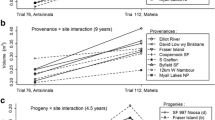Abstract
Forested land cleared for agriculture in the Blue Mountains of Jamaica rapidly loses its productivity leading to further slash-and-burn cultivation and the degradation of more forest. Contour hedgerows of Calliandra calothyrsus Meissner have been shown to reduce water runoff and soil erosion, and products of the species have a wide range of uses in the local farming community. A trial was established at 1550 m in which the locally naturalised population of C. calothyrsus was compared with seven provenances from across the species' ecological range. There was considerable variation between provenances of C. calothyrsus in all the above-ground growth variables measured and, although the local provenance performed moderately well, it was clear that there is potential to improve the suitability of the species for a range of local uses by the introduction of new provenances. One provenance combined high above-ground productivity with low fine root-length density, especially in the inter-hedgerow area: it offers particular potential for use in simultaneous agroforestry systems providing wood and foliage products whilst not imposing high levels of competition with crop plants for below-ground resources. Although there were significant differences between provenances in the distribution of roots between the hedgerow and inter-row areas, they did not differ in the distribution of roots between soil depths. There were only limited differences between provenances in the response of their subsequent growth to harvesting. However, significant block × provenance interactions suggested that the performance of C. calothyrsus provenances may be difficult to predict between sites and farmers should be encouraged to carry out trial planting of a number of provenances to find those which best match their farm environment and needs.
Similar content being viewed by others
References
Adams CD (1972) Flowering Plants of Jamaica. University of the West Indies, Mona, Jamaica, 848 pp
Bowen GD (1985) Roots as a component of tree productivity. In: Cannell MGR and Jackson JE (eds) Attributes of Trees as Crop Plants, pp 303–315. ITE, Abbots Ripton, UK
Cannell MGR (1985) Dry matter partitioning in tree crops. In: Cannell MGR and Jackson JE (eds) Attributes of Trees as Crop Plants, pp 160–193. ITE, Abbots Ripton, UK
Chamberlain JR (1998) Isozyme variation in Calliandra calothyrus (Leguminosae): its implications for species delimitation and conservation. Am J Bot 85: 37–47
Chamberlain JR and Hubert JD (2000) Molecular analyses of variation. In: Chamberlain JR (ed) Calliandra calothyrsus: an Agroforestry Tree for the Humid Tropics. Tropical Forestry Paper No. 40, Oxford Forestry Institute, Oxford, UK
Duguma B and Mollet M (1998) Early growth of Calliandra calothyrsus (Meissner) provenances in the acid soils of southern Cameroon. Agrofor Syst 40: 283–296
Eyre LA (1987) Fire in the tropical environment. Jamaica J 20: 10–16
FAO-UNESCO (1975) Soil Map of the World. Volume III. Mexico and Central America. UNESCO, Paris
Habeck JR (1958) White cedar ecotypes in Wisconsin. Ecology 39: 457–463
Huxley PA (1985) The basis of selection, management and evaluation of multipurpose trees-an overview. In: Cannell MGR and Jackson JE (eds) Attributes of Trees as Crop Plants, pp 13–35. ITE, Abbots Ripton, UK
Jones M, Sinclair FL and Grime V (1998) Effect of tree species and crown pruing on root length and soil water content in semi-arid agroforestry. Plant Soil 201: 199–210
Ledig FT (1983) The influence of genotype and environment on dry matter distribution in plants. In: Huxley PA (ed) Plant Research and Agroforestry, pp 427–454. ICRAF, Nairobi, Kenya
MacQueen DJ (1993) Calliandra series Racemosae: Taxonomic Information; OFI Seed Collections; Trial Design. Oxford Forestry Institute, Department of Plant Sciences, University of Oxford, 157 pp
McDonald JR, Healey PA Stevens and Devi Prasad PV (2000) Improved agroforestry systems for steeplands in the Caribbean. Forests in Sustainable Mountain Development: A State-of-Knowledge Report for 2000, Price, M & Butt, N (eds.) CABI (in press)
McGregor DFM, Barker D and Miller LA (1985) Land resources and development in the Upper Yallahs Valley, Jamaica: a preliminary assessment. Papers in Geography 18, Bedford College, University of London, UK
Morikawa B, Lantagne DO, Gold MA, Krecik S and Roshetko JM (1995) Managmeent of Calliandra calothyrsus for fodder production in Jamaica. Trop Grassl 29: 236–240
Owino F (1996) Selection and adaptation in multipurpose trees and shrubs for production and function in agroforestry system. Euphytica 92: 225–234
Pottinger A (1996) The international Calliandra network coordinated by the Oxford Forestry Institute. In: Evans DO (ed) International Workshop on the Genus Calliandra, pp 97–101. Proceedings of a workshop held January 23–27, 1996, in Bogor, Indonesia. Forest, Farm, and Community Tree Research Reports (Special Issue). Winrock International, Morrilton, Arkansas, USA
Riha SJ and McIntyre BD (1999) Water management with hedgerow agroforestry systems. In: Buck LE, Lassoie JP and Fernandes ECM (eds) Agroforestry in Sustainable Agricultural Systems, pp 47–66. CRC Press, Boca Raton, Florida
Roshetko JM, Lantagne DO, Gold MA, Morikawa B and Krecik S (1996) Recommendations for establishing and managing Calliandra calothyrsus as a fodder resource in Jamaica. In: Evans DO (ed) International Workshop on the Genus Calliandra, pp 168–179. Proceedings of a workshop held January 23–27, 1996, in Bogor, Indonesia. Forest, Farm, and Community Tree Research Reports (Special Issue). Winrock International, Morrilton, Arkansas, USA
Schroth G (1995) Tree root characteristics as criteria for species selection and systems-design in agroforestry. Agrofor Syst 30: 125–143
Shreve F (1914) A Montane Rain Forest. Carnegie Institute of Washington Publication Number 199, 110 pp.
Sinclair FL, Verinumbe I and Hall JB (1994) The role of domestication in agroforestry. In: Leakey RRB and Newton AC (eds) Tropical Trees: the Potential for Domestication and the Rebuilding of Forest Resources, pp 124–136. ITE, Penicuik, UK
Tennant, D (1975) A modified line intercept method for estimating root length. J Ecol 63: 995–1001
Young A (1997) Agroforestry for Soil Management. Second Edition. CAB International, UK
Author information
Authors and Affiliations
Corresponding author
Rights and permissions
About this article
Cite this article
McDonald, M.A., Healey, J.R. & Jones, M. Variations and phenotypic correlation of growth attributes of Calliandra calothyrsus in the Blue Mountains of Jamaica. Agroforestry Systems 50, 293–314 (2000). https://doi.org/10.1023/A:1006423926805
Issue Date:
DOI: https://doi.org/10.1023/A:1006423926805




